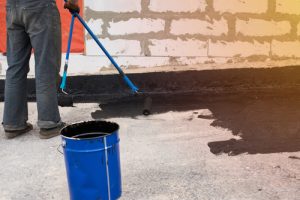Blog
Membrane Sealed Tanking: Type C Waterproofing Explained
 The struggle for space in a crowded city like London explains why many homeowners are beginning to look below ground for that last little bit of square footage. While a basement conversion can work wonders when it comes to adding space to your property, it's vital to ensure that your basement is fully waterproofed.
The struggle for space in a crowded city like London explains why many homeowners are beginning to look below ground for that last little bit of square footage. While a basement conversion can work wonders when it comes to adding space to your property, it's vital to ensure that your basement is fully waterproofed.
If you want to use your basement as an extra room in your house, waterproofing against groundwater will be an essential first step. Depending on the type of property and style of basement you have, one of two basement tanking methods will be recommended.
While Type A Waterproofing is more commonplace, Type C Waterproofing - Membrane Sealed Tanking - is more suited to certain properties. The below guide will give you an idea of the process involved with Type C Waterproofing, but as always, we would recommend enlisting the help of professionals like Garratt's Damp & Timber if you are looking for basement tanking services in London.
Step One - Surveying and Questions
Firstly, the team of specialist surveyors here at Garratt's Damp & Timber will examine your basement to determine the materials used in its construction. This should then inform us of the best method to waterproof your basement. The chances are that your basement will benefit from Type A Waterproofing; this is the option we usually find most beneficial for storage or where partial treatments to specific areas are required in basements. However, where the basement walls are subject to high volumes of groundwater, Type C Waterproofing may be a more optimal solution.
Step Two - Membrane, Piping, and Plumbing
The next step is to prepare the walls before installing the cavity membrane system to the walls and sometimes ceiling/soffit of the basement. This is detailed around services, doors and windows.
Membrane tanking requires expert knowledge and extremely precise engineering. Installed incorrectly, it could result in groundwater leaking through into the dry side of the membrane where the water will sit within the tanked area. It is essential to ensure that you employ only fully qualified professionals, like the team here at Garratt's Damp and Timber to complete such a project.
Step Three - Pump Installation and Perimeter Channels
Once the basement walls have been lined with membrane, a sump & pump with alarm system is concreted into place and perimeter channels are installed. The pump is then connected to the chosen discharge point that will take the water away from the property. This is then finished off with a layer of 20mm membrane to the floor making sure it’s neatly cut, taped and joined into place. If loss of height is an issue, we can bespoke the system to incorporate a Type C specification with a Type A epoxy resin to the floor. This is an example, occasionally, the specification will vary due to local conditions.
Step Four – Electrical Work, Finishings and Ventilation
The pump is then wired by a qualified electrician followed by a flood test to ensure the system is working and draining correctly. Our specialists then finish accordingly with flooring, plasterboard and skim finish allowing you to adjust your basement as you see fit.
Depending on the usage, there may be a need for additional ventilation to control heightened humidity levels.
Why Choose Type C Waterproofing?
Type C Waterproofing is generally more expensive than Type A, however, it is ideal for listed buildings where they have to retain the original structure and for when high volumes of groundwater are expected.
Membrane tanking (Type C) is certainly more technical than a Type A Waterproofing system, but Garratt's Damp and Timber offer an experienced team with exceptional confidence in our work. Because of this, we offer a 10-year guarantee on our basement tanking systems. Simply contact us today on 0208 535 7536.
Archived Articles
Recent
-
18 Mar 2024
How to Get Rid of Damp in Bedrooms
While it may seem more logical that kitchens and bathrooms are more prone to damp, it may be surprising for…
-
13 Nov 2023
Benefits of Tanking Your Basement
While basements have been a staple of home construction in multiple countries, they are still a relatively new concept in…
-
13 Nov 2023
Taking Action on Fixing Damp
Damp is a widespread problem in properties across the UK; however, this doesn’t stop the fact that it’s a serious…







